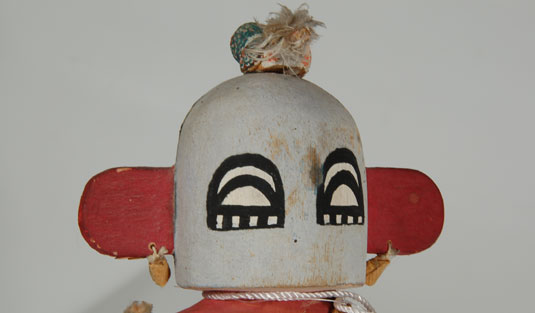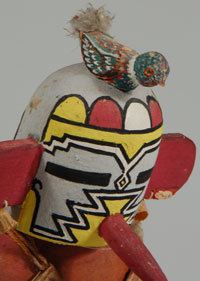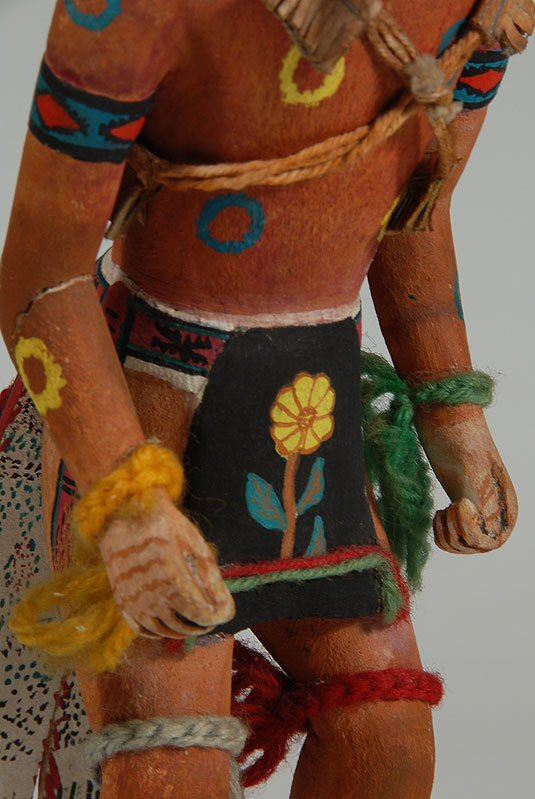Hopi Avachhoya (Corn) Katsina Doll [SOLD]
+ Add to my watchlist Forward to Friend
- Category: Traditional
- Origin: Hopi Pueblo, Hopituh Shi-nu-mu
- Medium: wood, paint, yarn, feathers
- Size: 11” tall
- Item # C3535.28 SOLD

 Avachhoya Katsina is one of many Corn Katsinas. Corn is the basis of Hopi life and katsinas dancing out a prayer for an abundant corn harvest reveals their great diversity. It is said that Corn Katsinas from almost every New Mexico Pueblo may be found represented among the Hopi Katsinas. Wright, 1975
Avachhoya Katsina is one of many Corn Katsinas. Corn is the basis of Hopi life and katsinas dancing out a prayer for an abundant corn harvest reveals their great diversity. It is said that Corn Katsinas from almost every New Mexico Pueblo may be found represented among the Hopi Katsinas. Wright, 1975
Generally this Corn Kachina dances with such a lively step that only the boys or young men will take the part. They do not sing and are always accompanied by a drummer and chorus, usually Koyemsi. Sometimes two of these kachinas will dance on the plaza by the side of the Niman Kachinas. Holding nothing in their hands, they make motions and signs describing such figures as clouds or cornstalks or whatever is being sung about at the time.
Pueblo people have lived in New Mexico and Arizona for two millennia and struggled to survive in those harsh climates. Precipitation arrives in brief powerful bursts during summer thunderstorms during the monsoon months of July and August. It is these summer rains that allows the corn to grow. But, other events threaten the crop—drought, insects, floods and other natural occurrences, so the pueblo people developed a religion to counter such events and gain favor with those deities who control water, sun, and earth who could assist them on earth.
This religion is that of the katsinas, a religion in which the people believe the spirits of the deceased ascend into the clouds and it is to them that the intercessions are directed. In essence, they are appealing to their ancestors for help. This religion has endured for a thousand or more years as evidenced by images of masked katsina-like figures on prehistoric kiva murals. Adams, 1991
This Avachhoya Katsina doll appears to be from the mid-1900s. The paints are matte, not shiny like acrylic paints used after World War II. It was beautifully carved and painted. There is no name of the artist, an indication that it was made for presentation to a young Hopi girl rather than having been made for sale. Dolls made for presentation to Hopi are never signed with a carver’s name as the dolls are gifts from the katsinas and the maker is anonymous.
Condition: very good condition with only a break at the elbow of the right arm which has been glued. The doll does not stand unaided and must be hung on a wall or have a stand made to support it. We can have a stand fabricated if desired.
Provenance: from the collection of a family from Oregon
References:
Wright, Barton: Kachinas: the Barry Goldwater Collection at the Heard Museum, W. A. Krueger Company, 1975. This book is currently not available from Adobe Gallery.
Adams, Charles E. The Origin and Development of the Pueblo Katsina Cult, University of Arizona Press, 1991. This book is currently not available from Adobe Gallery.

- Category: Traditional
- Origin: Hopi Pueblo, Hopituh Shi-nu-mu
- Medium: wood, paint, yarn, feathers
- Size: 11” tall
- Item # C3535.28 SOLD



